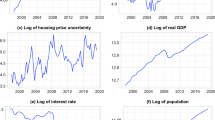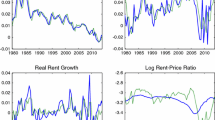Abstract
This study investigated the nonlinear effects of macroeconomic and financial uncertainty on regional housing prices in the USA. The sample data contain 50 largest metropolitan areas in the USA, and panel threshold regression was employed to test the nonlinear effects of macroeconomic and financial uncertainty. Regardless of using macroeconomic uncertainty or financial uncertainty as the threshold variable, the results of panel threshold regression confirm a nonlinear effect exists. Rising macroeconomic uncertainty, whether in the low or high regime, will reduce housing prices in most of the USA, but if macroeconomic risk reaches the high regime, the effect of macroeconomic uncertainty will be insignificant. Contrastingly, financial risk can have a positive effect on housing prices in the low and middle regimes of financial uncertainty, but this effect becomes negative in the high regime of financial uncertainty. These findings confirm that the responses of regional housing prices will differ if the macroeconomic and financial risk level is high.






Similar content being viewed by others
Notes
Bakas and Triantafyllou (2018) highlighted two different approaches to the measurement of economic uncertainty in the literature: observable and unobservable uncertainty measures. The former is based on the time series variations in observable economic variables, such as EPU (Baker et al., 2016). The latter is based on the empirical method of Jurado et al. (2015); here, it must be noted unobservable uncertainty cannot be measured by observed fluctuations in different economic variables, because these variables could change for reasons unrelated to uncertainty.
The exception is represented by Strobel et al. (2020), who also applied the economic uncertainty indices of JLN, but they only discussed the impact of macroeconomic uncertainty.
To avoid the spurious regression, all variables in Eq. (4) must be stationary. In Eq. (4), the dependent variable and three independent macroeconomic variables are stationary because they are first differences. Based on the ADF test of the model with trend, the ADF statistics are − 3.50 for MU and − 2.95 for FU, confirming MU and FU are also stationary.
References
Abel, A. B., & Eberly, J. C. (1999). The effects of irreversibility and uncertainty on capital accumulation. Journal of Monetary Economics, 44, 339–377.
Acharya, V., & Pedersen, L. (2005). Asset pricing with liquidity risk. Journal of Financial Economics, 77(2), 375–410. https://doi.org/10.1016/j.jfineco.2004.06.007
Adams, Z., & Füss, R. (2010). Macroeconomic determinants of international housing markets. Journal of Housing Economics, 19(1), 38–50.
Aye, G. C. (2018). Causality between economic policy uncertainty and real housing returns in emerging economies: A cross-sample validation approach. Cogent Economics & Finance, 6(1), 1–16. https://doi.org/10.1080/23322039.2018.1473708
Bahmani-Oskooee, M., & Ghodsi, S. H. (2017). Policy uncertainty and house prices in the United States. Journal of Real Estate Portfolio Management, 23(1), 73–85.
Bakas, D., & Triantafyllou, A. (2018). The impact of uncertainty shocks on the volatility of commodity prices. Journal of International Money and Finance, 87, 96–111. https://doi.org/10.1016/j.jimonfin.2018.06.001
Baker, S., Bloom, N., & Davis, S. (2016). Measuring economic policy uncertainty. The Quarterly Journal of Economics, 131, 1593–1636.
Balcilar, M., Roubaud, D., Uzuner, G. & Wohar, M. (2021). Housing and economic policy uncertainty in the OECD countries. International Review of Economics & Finance, 76(3). https://doi.org/10.13140/RG.2.2.35889.61286.
Bansal, R., & Yaron, A. (2004). Risks for the long run: A potential resolution of asset pricing puzzles. The Journal of Finance, 59(4), 1481–1509. https://doi.org/10.1111/j.1540-6261.2004.00670.x
Bardhan, A., Edelstein, R., & Tsang, D. (2007). Global financial integration and real estate security returns. Real Estate Economics, 36(2), 285–311.
Bernanke, B. S. (1983). Irreversibility, uncertainty, and cyclical investment. The Quarterly Journal of Economics., 98, 85–106.
Bhattacharya, S., Goodhart, C. A. E., Tsomocos, D. P., & Vardoulakis, A. P. (2015). A reconsideration of Minsky’s financial instability hypothesis. Journal of Money, Credit and Banking, 47(5), 931–973. https://doi.org/10.1111/jmcb.12229
Caballero, R. (1991). On the sign of the investment-uncertainty relationship. American Economic Review., 81, 279–288.
Chien, M. S., & Setyowati, N. (2020). The effects of uncertainty shocks on global housing markets. International Journal of Housing Markets and Analysis, 14(1), 218–242.
Choudhry, T. (2020). Economic policy uncertainty and house prices: Evidence from geographical regions of England and Wales. Real Estate Economics, 48(2), 504–529.
Christidou, M., & Fountas, S. (2017). Uncertainty in the housing market: Evidence from US states. Studies in Nonlinear Dynamics & Econometrics, 22(2), 20160064. https://doi.org/10.1515/snde-2016-0064
Christou, C., Gupta, R., & Hassapis, C. (2017). Does economic policy uncertainty forecast real housing returns in a panel of OECD countries? A Bayesian approach. The Quarterly Review of Economics and Finance, 65, 50–60. https://doi.org/10.1016/j.qref.2017.01.002
Christou, C., & Gupta, R., & Nyakabawo, W. (2019). Time-varying impact of uncertainty shocks on the US housing market. Economics Letters, Elsevier, 180(C), 15–20.
Craine, R. (1989). Risky business: The allocation of capital. Journal of Monetary Economics., 23, 210–218.
Di Pasquale, D., & Wheaton, W. (1994). Housing market dynamics and the future of housing prices. Journal of Urban Economics, 35, 1–27. https://doi.org/10.1006/juec.1994.1001
Dorofeenko, V., Lee, G. S., & Salyer, K. D. (2014). Risk shocks and housing supply: A quantitative analysis. Journal of Economic Dynamics and Control, 45, 194–219.
El-Montasser, G., Ajmi, A. N., Chang, T., Simo-Kengne, B. D., Andre, C., & Gupta, R. (2016). Cross-country evidence on the causal relationship between policy uncertainty and housing pricess. Journal of Housing Research, 25(2), 195–211.
Grum, B., & Govekar, D. K. (2016). Influence of macroeconomic factors on prices of real estate in various cultural environments: Case of Slovenia, Greece, France, Poland and Norway. Procedia Economics and Finance, 39, 597–604. https://doi.org/10.1016/s2212-5671(16)30304-5
Gupta, R., Lau, C. K. M., Plakandaras, V., & Wong, W. K. (2019). The role of housing sentiment in forecasting U.S. home sales growth: evidence from a Bayesian compressed vector autoregressive model. Economic Research-Ekonomska Istraživanja, 32(1), 2554–2567. https://doi.org/10.1080/1331677x.2019.1650657
Gyourko, J., & Saiz, A. (2006). Construction costs and the supply of housing structure. Journal of Regional Science, 46(4), 661–680. https://doi.org/10.1111/j.1467-9787.2006.00472.x
Han, L. (2008). Hedging housing prices risk in the presence of lumpy transaction costs. Journal of Urban Economics, 64(2), 270–287. https://doi.org/10.1016/j.jue.2008.01.002
Hansen, B. E. (1999). Threshold effects in non-dynamic panels: Estimation, testing, and inference. Journal of Econometrics, 93(2), 345–368. https://doi.org/10.1016/s0304-4076(99)00025-1
Harris, J. (1989). The effect of real rate of interest rate on housing prices. Journal of Real Estate, Finance, and Economics, 2(1), 47–60.
**jarak, Y., & Sheffrin, S. M. (2011). Causality, real estate prices, and the current account. Journal of Macroeconomics, 33(2), 233–246. https://doi.org/10.1016/j.jmacro.2010.11.001
Jurado, K., Ludvigson, S. C., & Ng, S. (2015). Measuring Uncertainty. American Economic Review, 105(3), 1177–1216.
Levin, E. J., & Pryce, G. B. J. (2009). What determines the price elasticity of house supply? Real interest rate effects and cyclical asymmetries. Housing Studies, 24(6), 713–736. https://doi.org/10.1080/02673030903215860
McCarthy, J., & Peach, R. W. (2004). Are home prices the next bubble? Federal Reserve Bank of New York Economic Policy Review, 10(3), 1–17.
Minsky, H. P. (1980). A theory of systemic fragility, Hyman P. Minsky Archive. 231.
Strobel, J., Nguyen Thanh, B., & Lee, G. (2020). Effects of macroeconomic uncertainty and labor demand shocks on the housing market. Real Estate Economics, 48(2), 345–372.
Author information
Authors and Affiliations
Corresponding author
Additional information
Publisher's Note
Springer Nature remains neutral with regard to jurisdictional claims in published maps and institutional affiliations.
Appendices
Appendix 1: Panel Threshold Regression using EPU as threshold variable
To examine the nonlinear effect of EPU on regional housing prices, panel threshold regression is employed to estimate Eq. (4) with EPU. Table 10 provides the statistics for F1, F2, and F3 and their bootstrap p-values using EPU as the threshold variable. As Table 10 shows, there are no threshold effects in the full sample and the South region and a double threshold effect in the other three regions. The results of panel threshold regression employing EPU as the threshold variable are displayed in Table 11. Comparing the results of Tables 6 and 9 by applying MU and FU as the threshold variable, in Table 11, the coefficients of dLr, dCONc, and dECa show similar results. The coefficients of EPU, for the first regime, are negative for the Northeast and West regions but positive in the Midwest region; for the second regime, the coefficients of EPU are significantly negative in the Midwest region and positive in the West region, while the coefficient is only significantly positive in the West region for the third regime. Hence, EPU has an ambiguous effect on different regional housing prices in the middle and high regimes.
Appendix 2: The results of threshold regression by applying time series data of each city
This section applies threshold regression further examining the effect of MU and FU on the housing prices of individual cities. In each of the four regions, we execute the estimation of time series for three cities with the highest, medium, and lowest housing prices. The 12 cities are named as follows: (1) the Midwest region—Minneapolis, Columbus, and Detroit; (2) the Northeast region—Boston, Newark, and Montgomery; (3) the West region—Portland, Oakland, and Riverside; (4) the South region—Austin, Jacksonville, and Atlanta.
In Table 12, using MU as the threshold variable, except for Detroit, Boston, and Oakland, MU has a single-threshold effect on housing prices in the other nine cities, and the results of threshold regression for the nine cities are as Table 13. In Table 13, the coefficients of dLr, dCONc, and dECa in most of the cities show similar results based on the data of four regional housing prices (in Table 6). For both regimes, the coefficients of MU are negative in all nine cities, and the coefficient of FU is positive in most of the nine cities.
In Table 14, using FU as the threshold variable, there is no threshold effect in Boston and a double-threshold effect on housing prices in the other eleven cities, and then the results of threshold regression for the eleven cities are displayed in Table 15. Comparing with the coefficients of the three economic variables based on the data of four regional housing prices (in Table 9), these coefficients show similar results in Table 15. The effect of MU is negative for most cites in the three regimes, but positive in the first regime for the cities in the Northeast and West regions. The effect of FU is positive for most cities in the first and third regimes, but negative for most cities in the second regime.
Rights and permissions
Springer Nature or its licensor (e.g. a society or other partner) holds exclusive rights to this article under a publishing agreement with the author(s) or other rightsholder(s); author self-archiving of the accepted manuscript version of this article is solely governed by the terms of such publishing agreement and applicable law.
About this article
Cite this article
Chien, MS., Setyowati, N. & Liu, SB. The nonlinear effect of macroeconomic and financial uncertainty on regional housing prices in the USA. J Hous and the Built Environ 38, 1529–1557 (2023). https://doi.org/10.1007/s10901-022-10003-z
Received:
Accepted:
Published:
Issue Date:
DOI: https://doi.org/10.1007/s10901-022-10003-z




